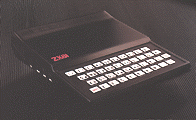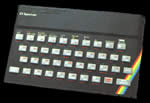Sinclair
ZX81 - 128+3
|
|
||||||
|
|
||||||
|
|
|||
| Being a kid and growing up in early 1980's were great times. We had great television shows like Airwolf, Knight Rider, and The A Team. Also the age of great pop music like Duran Duran, Haircut 100, Madness, Kid Creole and the Coconuts, even Shakin' Stevens; the list is endless. Yep those were great times. With all that you probably think that nothing could have been much better. Well, you'd be surprised that out of all the things I remember, enjoyed and cherished about the earlier 1980's (and late 1980's too), a small chunk of plastic, chips and wire was the greatest things the 1980's was all about. It name was the Sinclair ZX Spectrum, a compact home computer that was huge in its day, broke barriers and set stardards in home computing to be amired today. | |||
 |
|||
 |
If the PC is the great electronic product of the 1990's, the Sinclair Spectrum was the great electronic product of the 1980's. The Sinclair ZX Spectrum (nicknamed the Speccy) was invented by Sir Clive Sinclair, a British Inventor. His previous computing creations before the ZX Spectrum were the ZX80 and ZX81. In 1983, Sir Clive wanted to improve on the ZX81. At that time, Commordore had released their Vic 20 computer, a competitor to the ZX81. Sir Clive decided to build a computer with 48k of memory. In those days data was stored on cassette tape or microdrives (an earlier version of the 360k disk drive) and read by the CPU into the computer's memory. | ||
| In 1983, the ZX Spectrum was released. A small and light-weight compact home computer which had a rubber keyboard inhereted from the ZX80/81. At that same time the ZX Spectrum was released, I had a 2 year old Atari 2600 console. The Atari was a great games machine, but I felt drawn to the new range of home computers that were gradually becoming available. As I recall, The Commordore Vic 20 was being sold for $120. Also Commordore's new home computer named the Commordore 64 had been released for $200. The ZX Spectrum was for sale for a reasonable $150, including a free software pack (Tasword 2, Cheqard Flag, Make A Chip, Scrabble, VU 3D). With that offer, I pressed hard to convince my father to buy the ZX Spectrum for a Christmas Present. My Father, a computer addict himself who loved Asteriods and Space Invaders for the Atari 2600, didn't take too much time to convince him that the ZX Spectrum was the best thing since the Beatles. So that Christmas I received a ZX Spectrum, a home computer that would change my life. |  |
||
| For the next 6 years the ZX Spectrum and I went through a lot of changes. My pocket money was spent on games, and when it came to Christmas, my birthday, or any other special occasion, I would chose to have a Spectrum game over anything else. During the ZX Spectrum life, more advanced Spectrum machines hit the market. In 1984 the Sinclair QL was launch. The QL was aimed toward the more business area of the market, specialising more in application than games. Alas the Sinclair QL was too ahead of it's time, and failed to attract customers, mainly because the UK wasn't prepared for it. Other releases included the Spectrum 48k Plus, a more harded keyboard version of it rubber counterpart. A year later, the Sinclair Spectrum 128k appeared. This allowed multi-load games that were becoming more popular to be loaded into memory once, instead of rewinding the cassette and reloading a previous level of a game. At that current time, Sir Clive was in a deal with a Mr Alan Sugar. Alan Sugar - if you don't know your computing history - was the owner of Amstrad. Apart from the Sinclair and Commordore, Amstrad was the 3rd most popular home computer maker in the UK. Although being in 3rd place, Amstrad were seeing their sale affected by their 2 main competitors. In 1986, Alan Sugar struck a deal with Sir Clive Sinclair, and brought the rights to developed Spectrum machines. With this power, Amstrad redesigned and market it's version of the Sinclair Spectrum 128K, calling it the Plus 2 (+2). The Sinclair Spectrum 128+2 was a big redesign. Like Amstrads CPC home computer, the 128+2 had a built-on tape desk and a proper keyboard. It was also coloured in light grey, unlike the previous spectrum that were coloured in black. It sold in the UK for $150, again with a software pack included (the best gaming being Ho Mummy). Too make thing comlicated, Amstrad released 2 version of the 128+2 in 2 years. Some Version 1 128+2 had tape deck problems. Some games wouldn't load properly, so backward compatitbility started to creep in. Amstrad saw this, and quickly released version 2. I purchased both version 1 and 2 of the 128+2, and really could noticed much difference between them. Anyway around this time, Personal computer were becoming more know. Amstrad looked to their future created a new market plan which unfortunately did included the continuation of the ZX Spectrum. Before Amstrad started fading the Spectrum out of their plans, they release the Sinclair Spectrum 128+3. This was exactly like the 128+2 but instead of a built-on tape desk, it had a built-on disk drive, and sold for $50 more than the 128+2. Although this seemed a great idea, the cassette deck version was more popular, and proved to be a great investment for Spectrum user who wanted the most out of the Spectrum. The Spectrum gaming scene was more alive than even, and computer mags like Crash, Sinclair User, and Your Sinclair began attaching cassettes with demos, and software cheat programs on them. This progressed through the later half of the 1980's which mags began even put full software title on their free cassettes. Has you guessed this started the craze of free software/demos which we get on the front cover of the PC mags of today. | |||
 |
|||
| By 1988, Atari had
brought out it Atari ST, and Commordore upgrade it home computer to
the Commordore Amiga. both machines were suporior in terms of graphics,
speed, sound, against the Spectrum. The Spectrum although up against
much stronger competition, hang on for a couple more years. I would
say this was due to the support of the Spectrum users and magazines
that kept the Spectrum alive to it's demise at the beginning of the
1990's. You could say the 1990's killed the Spectrum, but the world
is a very mysterious place. I say that because in the mid 1990's,
alot of people began look back again to the 1980's. Yep, repeats of
The A Team began showing on televison, and Duran Duran brought out
a new album after a 7 year absents. At the same time, emulation of
home computers began appearing. Though at first they we practically
unplayable, a couple of years on, they play just like the Spectrum
did, all those years ago. They can be run on new more advanced home
computers called PC's (hey I'm being a bit scarcastic here). So the
ressurection of the ZX Spectrum has happened, and the Speccy is alive.
Once again we can live through our youth and play all our favourite
games that made us the geeks we are today.
Lee Friend |
|||
|
©2002 ZeDeX82
|